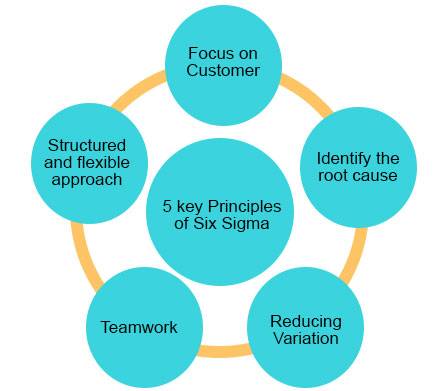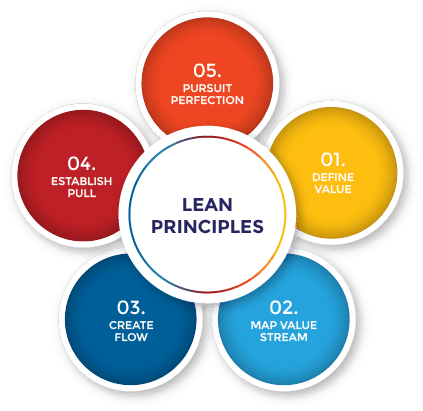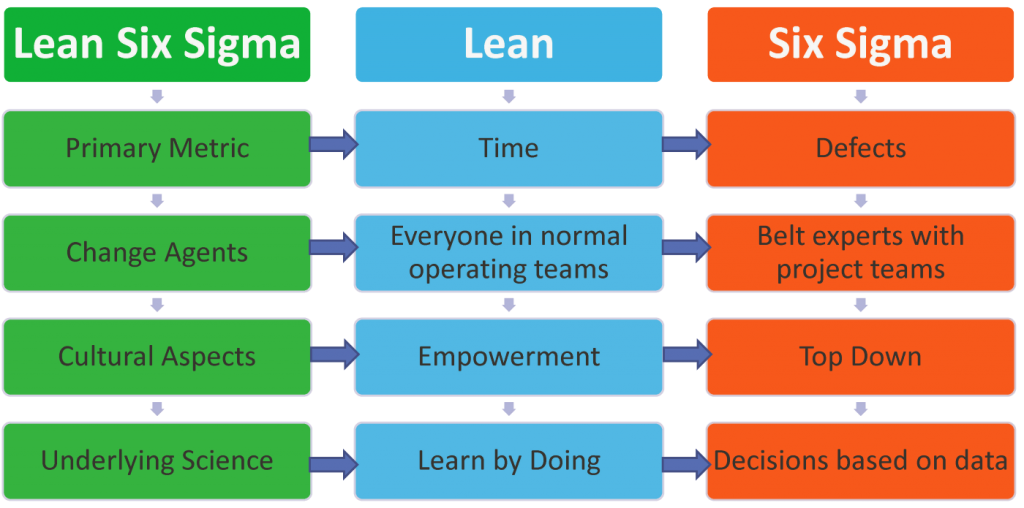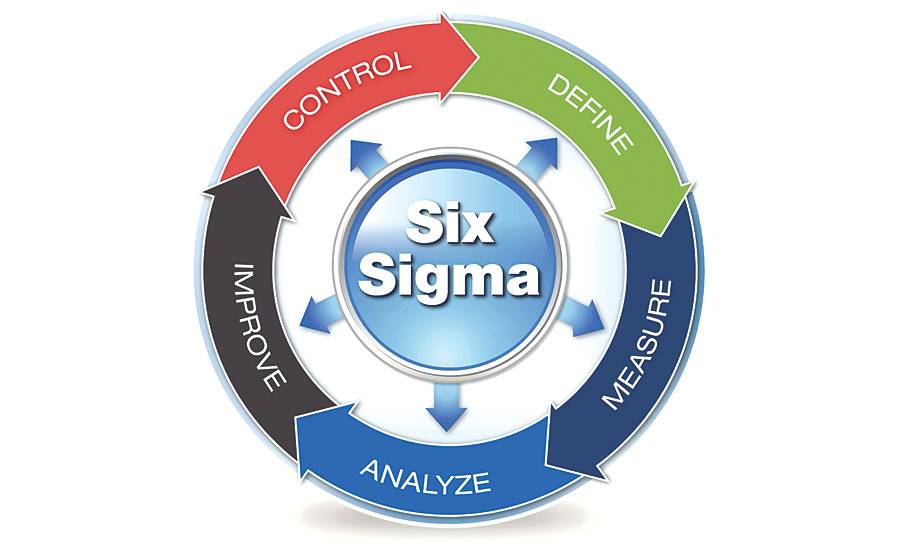Table of Contents
“Quality is never an accident; it is always the result of high intention, sincere effort, intelligent direction and skillful execution; it represents the wise choice of many alternatives.” William A. Foster
Upcoming Batches of Six Sigma Green Belt Certificate :-
| Batch | Mode | Price | To Enrol |
|---|---|---|---|
| Starts Every Week | Live Virtual Classroom | 19500 | ENROLL NOW |
You may be surprised to know that even every kitchen likely follows the “5S” method5S Means
Sort
Straighten
Shine
Standardize
Sustain
when you routinely go through your fridge to toss products that are expired, you’re sorting.
Keeping everything organized in the same (Straighten), easy-to-reach place (Shine) ensures your kitchen is set in order and standardized.
Systematic cleaning ensures your kitchen is always a safe place to prepare meals
Following through on each of these means you are sustaining the discipline.

Quality in manufacturing
- a measure of excellence
- a state of being free of defects, deficiencies
- is consistent adherence to measurable verifiable standards to achieve uniformity of output
- is Significant variations brought to satisfies specific customer or user requirements.
Quality practitioners are a special category of people who organize, manage, measure, calculate, observe and constantly try to improve processes.
Quality practitioners use different tools to achieve this and may seem to be in a world of their own. One of well recognized quality tool is Six sigma.

Six Sigma is a quality management tool used to help businesses improve current processes, products or services by discovering and eliminating defects.
The goal is to streamline the quality control in manufacturing or business processes hence there is little to no variance throughout.
Six Sigma’s is focused on eliminating defects and reducing variation.
Henry Harvin Also Provide These Courses:
Key principles Six Sigma

- Focus on the customer.
- Identification and understanding of how the work gets done (the value stream).
- Manage, improve and smooth the process flow.
- Remove Non-Value-Added steps and waste.
- Manage by fact and reduce variation.
Six Sigma is very useful to
#Maximize customer satisfaction by minimizing defects.
#Define and Improve processes.
#Improve quality and achieve a zero defect performance.
#Design and redesign processes.
#Process management.
Six Sigma Training
Six Sigma training helps to use tools to improve the capabilities of organizations their business processes.
Also helps to control on the inputs leads which to control the outputs .
Lean Philosophy
a philosophical way of working which emphasizes the removal of waste within a process.
believes in creation of value for the end customer.
Lean management
focused on eliminating waste using a set of proven standardized tools and methodologies for organizational efficiencies.
are used during integrating of performance improvement system
Lean Principles

1. Define Value
Value is what the customer is willing to pay for.
It is very important to discover the actual or latent needs of the customer.
By using different qualitative and quantitative techniques you can uncover :
#what customers want,
#how they want the product or service to be delivered and
#the price that they afford
2. Map the Value Stream
Uses the customer value as a reference point and identify all the activities that contribute to these values.
Activities which do not add value to the end customer are considered waste.
The waste can be broken into two categories:
- non-valued added but necessary should be reduced as far as possible
- non-value added but unnecessary should be eliminated
By reducing and eliminating unnecessary processes or steps, can ensure that customers get exactly what they want while at the same time reducing the cost of producing that product or service.
3. Create Flow
The follow up action is to ensure that the flow of the steps run smoothly without interruptions or delays.
Some strategies for ensuring that value-adding activities flow smoothly include:
- breaking down steps,
- re configuring the production steps
- leveling out the workload
- creating cross-functional departments
- training employees to be multi-skilled and adaptive.
4. Establish Pull
The objective of a pull-based system is to limit inventory and work In Process (WIP) items.
Ensuring the requisite materials and information are available for a smooth flow of work.
Pull-based systems are always created based on the needs of the end customers.
By adopting the value stream and working backwards through the production system, can ensure that the products produced will be able to satisfy the needs of customers.
5. Pursue Perfection
Perfection makes continuous process improvement a part of the organizational culture.
Every one must strive towards perfection while delivering products based on the customer needs.
The company should be a learning organization and always find ways to get a little better each and every day.
Advantages of lean principles
Provides a framework for creating an efficient and effective organization.
Lean allows the managers to discover inefficiencies in their organization and deliver better value to customers.
The principles encourage creating better flow in work processes and developing a continuous improvement culture.
By practicing all principles, an organization can remain competitive, increase the value delivered to the customers, decrease the cost of doing business, and increase their profitability.
It is important to note

#Lean and Six Sigma are incomplete without each other.
#Both have their own unique features which need to be implemented together for better quality management production.
Lean Six Sigma
Lean Six Sigma
is a method that relies on a collaborative team effort to improve performance by systematically removing waste and reducing variation.
Purpose of Lean Six Sigma
provides organizations the tools to improve the capability of their business processes.
increases the performance
Decrease the process variation that ….
- lead to defect reduction
- improvement in profits,
- employee morale,
- quality of products or services.
Benefits of Lean Six Sigma
Lean Six Sigma provides various benefits for organizations.
It not only saves money
but also changes the attitude of employees and the functionality of the organization.
Through implementation of Lean Six Sigma, organizations can expect the beneficial outcomes like:
- Increase in Profit
- Standardized and Simplified Processes
- Decrease in error
- Employee Performance/Development
- Value to Customer
#Six Sigma is a program, does not attempt at organizational culture change.
#Lean Six Sigma is both a program and a philosophy that attempts both.
How to implement lean Six Sigma?
Lean Six Sigma can be implemented by DMAIC methodology

DMAIC is a data-driven problem-solving approach for achieving Process excellence, it has 5 phases
Define Define the Problem
Measure Measure the Problem
Analyze Identify the actual cause of the problem
Improve Try to solve the actual root cause of the problem
Control Maintain or control
Steps for Successful Implementation lean Six Sigma
1: Create a Burning Platform 2: Put Resources in Place 3: Teach the Methodology 4: Prioritize Activities 5: Establish Ownership 6: Take the Right Measurements 7: Govern the Program 8: Recognize Contributions.
# Lean Six Sigma training
As per ASQ (American Society for Quality) it is a fact based, data driven plosophy of improvement that values defect prevention over defect detection.
Lean Six Sigma training helps to provide customer satisfaction and bottom-line results by reducing variation, waste and cycle time, while promoting the use of work standardization and flow, thereby creating an competitive advantage.
Recommended Reads
- Best Six Sigma Course in India
- Best Six Sigma Courses in Bangalore
- Best Six Sigma Black Belt Courses in Delhi
- Best Six Sigma Courses in Chennai
- Six Sigma Black Belt Courses in India
- Six Sigma Certification Costs
It applied where variation and waste exist, and every employee should be involved.
The industry, domain, and subject-matter experts develop a generic criterion, in terms of pre -certification and post-certification effort & experience levels.
Recommended Programs
Lean Six Sigma Green Belt
Certification Training
Ranked No.1 Six Sigma Certification in India | Aligned to IASSC Book of Knowledge | Combining Lean and DMAIC Methodology to Impart Key Skills | Gain Experience of 12+ Projects | Both Classroom and Live Online Options Available
Lean Six Sigma Black Belt
Certification Training
Ranked No.1 Six Sigma Black Belt Certification in India | 9361+ Participants Trained | Aligned to IASSC Book of Knowledge (BOK) | Gain Advanced Expertise Over Lean and Six Sigma Methodology| Gain Experience of 12+ Projects | Both Classroom and Live Online Options Available
Lean Six Sigma Master
Black Belt Certification
Step-in to a new designation of being Explicit Quality Professional | Get acknowledged as a Lean Six Sigma Evangelist | Connect to the rarest community of worldwide Black Belt specialists | Validate your professional skills in leading intricate projects | Execute Lean methodologies with perfection.
Explore Popular Category







![Top 7 Technical Skills For Career in Biotechnology in 2024 [Updated]](https://hh-certificates.sgp1.digitaloceanspaces.com/blog/wp-content/uploads/2020/05/03101316/7575fa69-8f6e-4665-ad73-ea7c2182d05c-270x180.png)

![Top 11 Key Accountant Resume Skills in 2024 [Updated]](https://hh-certificates.sgp1.digitaloceanspaces.com/blog/wp-content/uploads/2022/06/17130428/pasted-image-0-2022-10-17T183415.434-270x180.jpg)
.webp)
